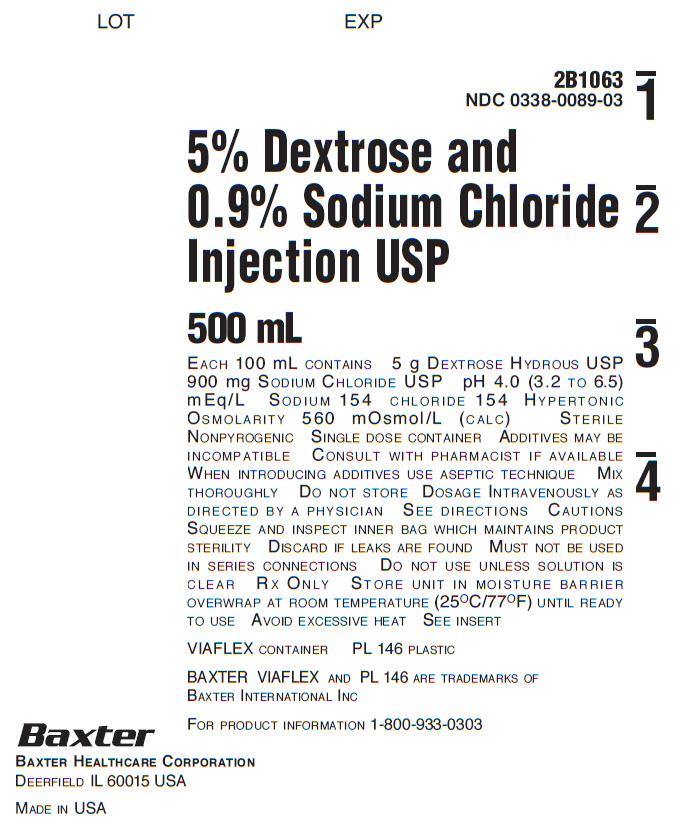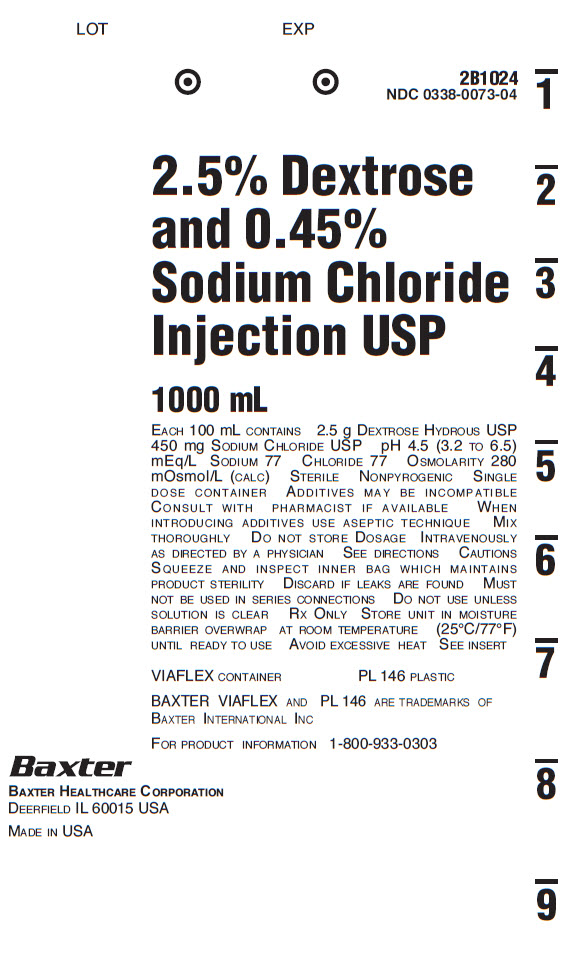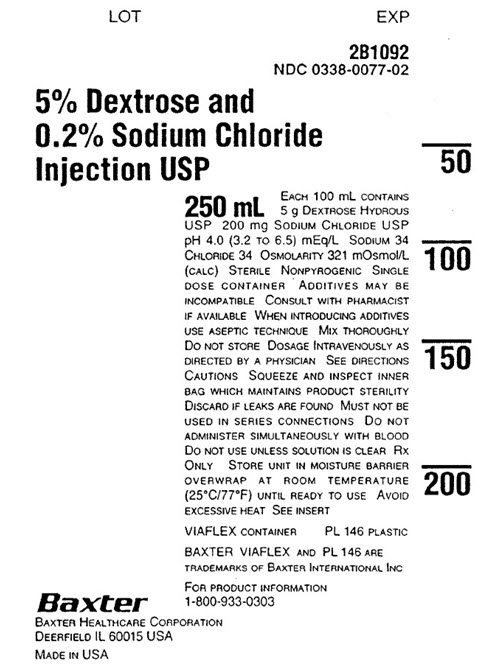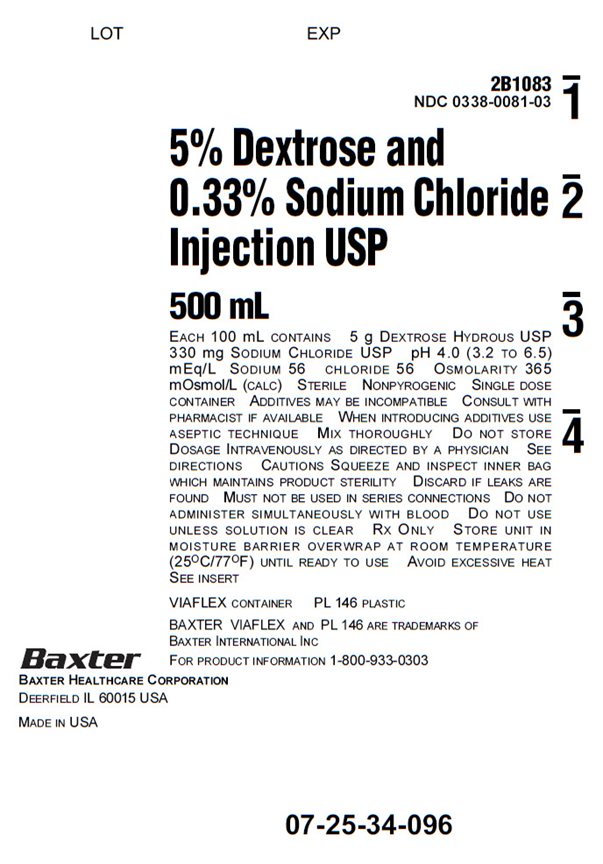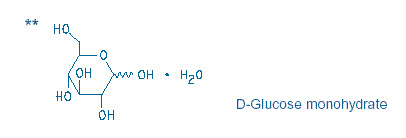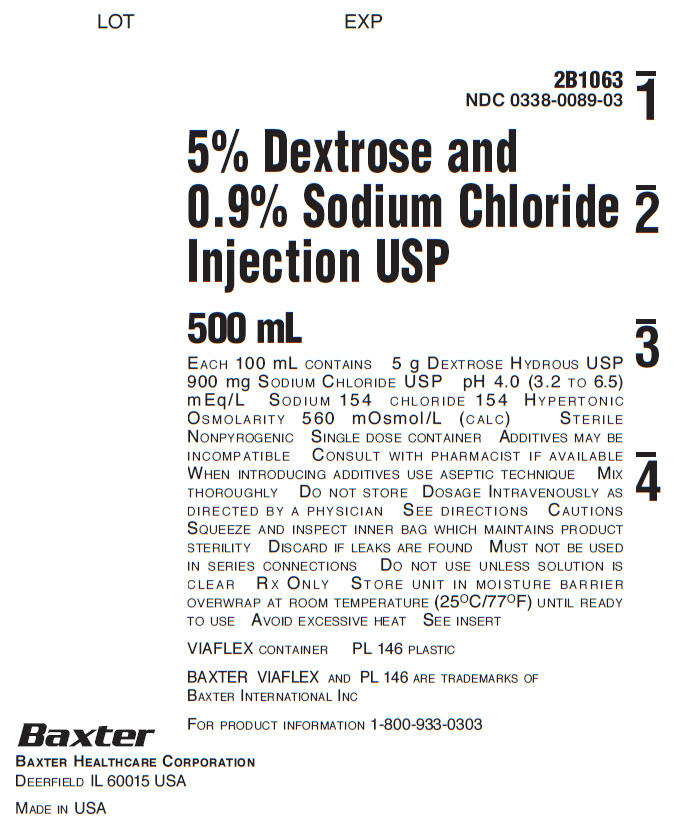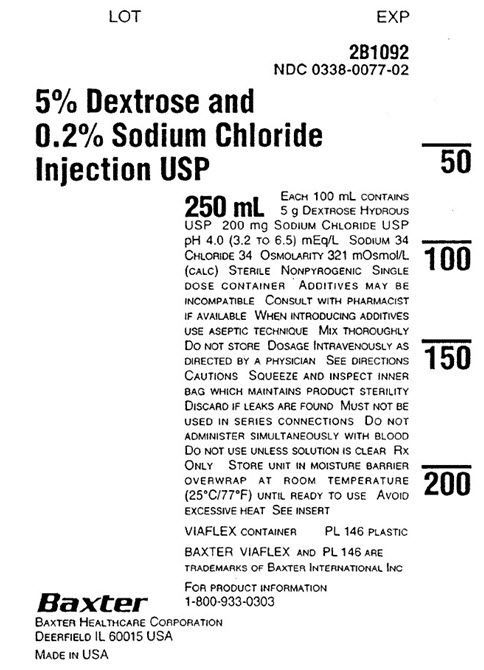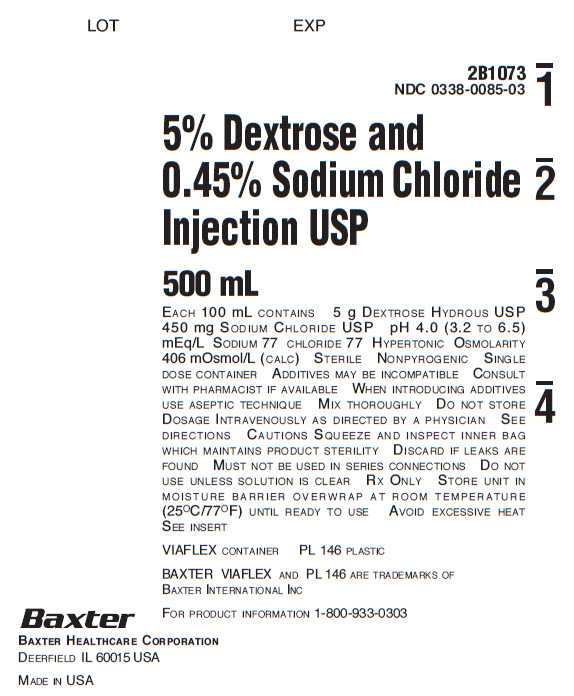Label: DEXTROSE AND SODIUM CHLORIDE injection, solution
-
NDC Code(s):
0338-0073-04,
0338-0077-02,
0338-0077-03,
0338-0077-04, view more0338-0081-03, 0338-0085-03, 0338-0085-04, 0338-0089-03, 0338-0089-04
- Packager: Baxter Healthcare Corporation
- Category: HUMAN PRESCRIPTION DRUG LABEL
- DEA Schedule: None
- Marketing Status: New Drug Application
Drug Label Information
Updated August 22, 2019
If you are a consumer or patient please visit this version.
- Download DRUG LABEL INFO: PDF XML
- Official Label (Printer Friendly)
-
HIGHLIGHTS OF PRESCRIBING INFORMATION
These highlights do not include all the information needed to use DEXTROSE AND SODIUM CHLORIDE INJECTION safely and effectively. See full prescribing information for DEXTROSE AND SODIUM CHLORIDE INJECTION.
DEXTROSE AND SODIUM CHLORIDE injection, for intravenous use
Initial U.S. Approval: 1970RECENT MAJOR CHANGES
INDICATIONS AND USAGE
Dextrose and Sodium Chloride Injection is indicated as a source of water, electrolytes and calories. (1)
DOSAGE AND ADMINISTRATION
DOSAGE FORMS AND STRENGTHS
Dextrose and Sodium Chloride Injection is available in multiple strengths. See full prescribing information for detailed description of each product. (3)
CONTRAINDICATIONS
WARNINGS AND PRECAUTIONS
- •
- Hypersensitivity Reactions: Monitor for signs and symptoms and discontinue infusion if reactions occur. (5.1)
- •
- Hyperglycemia or Hyperosmolar Hyperglycemic State: Monitor blood glucose and administer insulin as needed. (5.2, 8.4)
- •
- Hyponatremia, Hypokalemia, Hypernatremia and Hyperchloremia: Avoid in patients with or at risk for hypo-/hypernatremia and hypokalemia. If use cannot be avoided, monitor serum sodium and potassium concentrations. (5.3, 5.4, 5.5, 8.4)
- •
- Fluid Overload: Avoid in patients with or at risk for fluid and/or solute overloading. If use cannot be avoided, monitor daily fluid balance and electrolyte, concentrations and acid-base balance, as needed and especially during prolonged use. (5.6)
- •
- Refeeding Syndrome: Monitor severely undernourished patients and slowly increase nutrient intake. (5.7)
ADVERSE REACTIONS
Adverse reactions include electrolyte imbalances, hyperglycemia, and hypervolemia and injection site reactions. (6)
To report SUSPECTED ADVERSE REACTIONS, contact Baxter Healthcare at 1-866-888-2472 or FDA at 1-800-FDA-1088 or www.fda.gov/medwatch.
DRUG INTERACTIONS
- •
- Other Products that Affect Glycemic Control, Vasopressin or Fluid and/or Electrolyte Balance: Monitor blood glucose concentrations, fluid balance serum electrolyte concentrations and acid-base balance. (7.1)
- •
- Lithium: Decreased lithium concentrations with concomitant use; monitor serum lithium concentrations. (7.2)
See 17 for PATIENT COUNSELING INFORMATION.
Revised: 8/2019
-
Table of Contents
FULL PRESCRIBING INFORMATION: CONTENTS*
1 INDICATIONS AND USAGE
2 DOSAGE AND ADMINISTRATION
2.1 Important Administration Instructions
2.2 Recommended Dosage
2.3 Instructions for Use
3 DOSAGE FORMS AND STRENGTHS
4 CONTRAINDICATIONS
5 WARNINGS AND PRECAUTIONS
5.1 Hypersensitivity Reactions
5.2 Hyperglycemia and Hyperosmolar Hyperglycemic State
5.3 Hyponatremia
5.4 Hypokalemia
5.5 Hypernatremia and Hyperchloremia
5.6 Fluid Overload
5.7 Refeeding Syndrome
6 ADVERSE REACTIONS
7 DRUG INTERACTIONS
7.1 Other Products that Affect Glycemic Control, Vasopressin or Fluid and/or Electrolyte Balance
7.2 Lithium
8 USE IN SPECIFIC POPULATIONS
8.1 Pregnancy
8.2 Lactation
8.4 Pediatric Use
8.5 Geriatric Use
8.6 Renal Impairment
10 OVERDOSAGE
11 DESCRIPTION
12 CLINICAL PHARMACOLOGY
12.1 Mechanism of Action
16 HOW SUPPLIED/STORAGE AND HANDLING
17 PATIENT COUNSELING INFORMATION
- *
- Sections or subsections omitted from the full prescribing information are not listed.
- 1 INDICATIONS AND USAGE
-
2 DOSAGE AND ADMINISTRATION
2.1 Important Administration Instructions
- •
- Dextrose and Sodium Chloride Injection is only for intravenous infusion.
- •
- The osmolarity of Dextrose and Sodium Chloride Injection, ranges from 280 to 560 mOsmol/L (calc). Peripheral administration is generally acceptable; however; consider central vein administration if there is peripheral vein irritation, phlebitis, and/or associated pain.
- •
- Do not administer Dextrose and Sodium Chloride Injection simultaneously with blood products through the same administration set because of the possibility of pseudoagglutination or hemolysis.
- •
- To prevent air embolism, use a non-vented infusion set or close the vent on a vented set, avoid multiple connections, do not connect flexible containers in series, fully evacuate residual gas in the container prior to administration, do not pressurize the flexible container to increase flow rates, and if administration is controlled by a pumping device, turn off pump before the container runs dry.
- •
- Prior to infusion, visually inspect the solution for particulate matter. The solution should be clear and there should be no precipitates. Do not administer unless solution is clear and container is undamaged.
- •
- Use of a final filter is recommended during administration of parenteral solutions, where possible.
2.2 Recommended Dosage
The choice of the specific, sodium chloride, and dextrose concentrations, rate and volume depends on the age, weight, clinical and metabolic conditions of the patient and concomitant therapy. Electrolyte supplementation may be indicated according to the clinical needs of the patient.
The administration rate should be governed, especially for premature infants with low birth weight, during the first few days of therapy, by the patient’s tolerance to dextrose. Increase the infusion rate gradually as indicated by frequent monitoring of blood glucose concentrations [see Warnings and Precautions (5.2), Use in Specific Populations (8.4)].
2.3 Instructions for Use
To Open
- •
- Do not remove container from overwrap until ready to use.
- •
- Tear overwrap down side at slit and remove solution container.
- •
- Visually inspect the container. Some opacity of the plastic due to moisture absorption during the sterilization process may be observed. This is normal and does not affect the solution quality or safety. The opacity will diminish gradually. Evaluate the following:
- ∘
- If the outlet port protector is damaged, detached, or not present, discard container.
- ∘
- Check to ensure the solution is clear and there are no precipitates. Discard if there is a color change and/or the appearance of precipitates, insoluble complexes or crystals.
- ∘
- Check for minute leaks by squeezing inner bag firmly. If leaks are found, discard container.
Preparation for Administration
- 1.
- Suspend container from eyelet support.
- 2.
- Remove protector from outlet port at bottom of container.
- 3.
- Attach administration set. Refer to complete directions accompanying set.
To Add Medication
- •
- Additives may be incompatible. Complete information is not available. Do not use additives known or determined to be incompatible.
- •
- Consult with pharmacist, if available. If, in the informed judgment of the healthcare provider, it is deemed advisable to introduce additives, use aseptic technique.
- •
- When introducing additives, consult the instructions for use of the medication to be added and other relevant literature.
- •
- Before adding a substance or medication, verify that it is soluble and/or stable in Dextrose and Sodium Chloride Injection and that the pH range of Dextrose and Sodium Chloride Injection is appropriate.
To Add Medication Before Solution Administration
- 1.
- Prepare medication site.
- 2.
- Using syringe with 19 to 22-gauge needle, puncture resealable medication port and inject.
- 3.
- Mix solution and medication thoroughly. For high density medication such as potassium chloride, squeeze ports while ports are upright and mix thoroughly.
- 4.
- After addition, check to ensure the solution is clear and there are no precipitates. Discard if there is a color change and/or the appearance of precipitates, insoluble complexes or crystals.
To Add Medication During Solution Administration
- 1.
- Close clamp on the set.
- 2.
- Prepare medication site.
- 3.
- Using syringe with 19 to 22-gauge needle, puncture resealable medication port and inject.
- 4.
- Remove container from IV pole and/or turn to an upright position.
- 5.
- Evacuate both ports by squeezing them while container is in the upright position.
- 6.
- Mix solution and medication thoroughly.
- 7.
- After addition, check to ensure the solution is clear and there are no precipitates. Discard if there is a color change and/or the appearance of precipitates, insoluble complexes or crystals, do not use.
- 8.
- Return container to in use position and continue with administration.
Storage
- •
- Use promptly; do not store solutions containing additives.
- •
- Single-dose container.
- •
- Discard any unused portion.
-
3 DOSAGE FORMS AND STRENGTHS
Dextrose and Sodium Chloride Injection are clear solutions in 250 mL, 500 mL and 1000 mL single-dose, flexible containers:
250 mL flexible container
- •
- 5% Dextrose and 0.2% Sodium Chloride Injection, USP
500 mL flexible container
- •
- 5% Dextrose and 0.2% Sodium Chloride Injection, USP
- •
- 5% Dextrose and 0.33% Sodium Chloride Injection, USP
- •
- 5% Dextrose and 0.45% Sodium Chloride Injection, USP
- •
- 5% Dextrose and 0.9% Sodium Chloride Injection, USP
1000 mL flexible container
- •
- 2.5% Dextrose and 0.45% Sodium Chloride Injection, USP
- •
- 5% Dextrose and 0.2% Sodium Chloride Injection, USP
- •
- 5% Dextrose and 0.45% Sodium Chloride Injection, USP
- •
- 5% Dextrose and 0.9% Sodium Chloride Injection, USP
-
4 CONTRAINDICATIONS
Dextrose and Sodium Chloride Injection is contraindicated in patients with:
- •
- known hypersensitivity to dextrose and/or sodium chloride [see Warnings and Precautions 5.1)]
- •
- clinically significant hyperglycemia [see Warnings and Precautions (5.2)]
-
5 WARNINGS AND PRECAUTIONS
5.1 Hypersensitivity Reactions
Hypersensitivity and infusion reactions, including anaphylaxis, have been reported with Dextrose and Sodium Chloride Injection [see Adverse Reactions (6)]. Stop the infusion immediately if signs or symptoms of a hypersensitivity or infusion reaction develops [see Contraindications (4)]. Appropriate therapeutic countermeasures must be instituted as clinically indicated.
5.2 Hyperglycemia and Hyperosmolar Hyperglycemic State
The use of dextrose infusions in patients with impaired glucose tolerance may worsen hyperglycemia. Administration of dextrose at a rate exceeding the patient’s utilization rate may lead to hyperglycemia, coma, and death.
Hyperglycemia is associated with an increase in serum osmolality, resulting in osmotic diuresis, dehydration and electrolyte losses. Patients with underlying central nervous system disease and renal impairment who receive dextrose infusions, may be at greater risk of developing hyperosmolar hyperglycemic state.
Monitor blood glucose concentrations and treat hyperglycemia to maintain concentrations within normal limits while administering Dextrose and Sodium Chloride Injection. Insulin may be administered or adjusted to maintain optimal blood glucose concentrations.
5.3 Hyponatremia
Dextrose and Sodium Chloride Injection is a hypertonic solution [see Description, Table 1 (11)]. In the body, however, glucose containing fluids can become extremely physiologically hypotonic due to rapid glucose metabolization. Monitoring of serum sodium is particularly important for hypotonic fluids.
Depending on the tonicity of the solution, the volume and rate of infusion, and depending on a patient’s underlying clinical condition and capability to metabolize glucose, intravenous administration of glucose can cause electrolyte disturbances, most importantly hypo- or hyperosmotic hyponatremia.
The risk for hyponatremia is increased, in pediatric patients, elderly patients, postoperative patients, those with psychogenic polydipsia and in patients treated with medications that increase the risk of hyponatremia (such as certain diuretic, antiepileptic and psychotropic medications) [see Drug Interactions (7.1)].
Acute hyponatremia can lead to acute hyponatremic encephalopathy characterized by headache, nausea, seizures, lethargy and vomiting. Patients with brain edema are at particular risk of severe, irreversible and life-threatening brain injury. Patients at increased risk for developing complications of hyponatremia, such as hyponatremic encephalopathy include pediatric patients; women, in particular, premenopausal women; patients with hypoxemia; and in patients with underlying central nervous system disease [see Use in Specific Populations (8.4, 8.5)].
Avoid Dextrose and Sodium Chloride Injection in patients with or at risk for hyponatremia. If use cannot be avoided, monitor serum sodium concentrations.
Rapid correction of hyponatremia is potentially dangerous with risk of serious neurologic complications such as osmotic demyelination syndrome with risk of seizures and cerebral edema. To avoid complications, monitor serum sodium and chloride concentrations, fluid status, acid-base balance, and signs of neurologic complications.
High volume infusion must be used with close monitoring in patients with cardiac or pulmonary failure, and in patients with non-osmotic vasopressin release (including SIADH), due to the risk of hospital-acquired hyponatremia.
5.4 Hypokalemia
Excessive administration of Dextrose and Sodium Chloride Injection may result in significant hypokalemia. Hypokalemic periodic paralysis, metabolic alkalosis, increased gastrointestinal losses (e.g. diarrhea, vomiting), prolonged low potassium diet, or primary hyperaldosteronism may increase the risk of hypokalemia.Avoid the administration of Dextrose and Sodium Chloride Injection in patients with or at risk of hypokalemia or taking medications that may increase the risk. If use cannot be avoided, monitor serum potassium levels.
5.5 Hypernatremia and Hyperchloremia
Electrolyte imbalances such as hypernatremia and hyperchloremia, leading to metabolic acidosis may occur with solutions containing 0.9% sodium chloride.
Conditions that may increase the risk of hypernatremia, fluid overload and edema (central and peripheral), include patients with pre-eclampsia, primary hyperaldosteronism and secondary hyperaldosteronism associated with, for example, hypertension, congestive heart failure, severe renal impairment, liver disease (including cirrhosis), and renal disease (including renal artery stenosis, nephrosclerosis).
Medications such as corticosteroids or corticotropin, may increase the risk of sodium and fluid retention.
Avoid in patients with or at risk for hypernatremia. If use cannot be avoided, monitor serum sodium concentrations.
Rapid correction of hypernatremia is potentially dangerous with risk of serious neurologic complications. Excessively rapid correction of hypernatremia is also associated with a risk for serious neurologic complications such as osmotic demyelination syndrome (ODS) with risk of seizures and cerebral edema.
5.6 Fluid Overload
Depending on the volume and rate of infusion, the patient’s underlying clinical condition and capability to metabolize dextrose, intravenous administration of Dextrose and Sodium Chloride Injection can cause fluid and/or solute overloading resulting in dilution of serum electrolyte concentrations, overhydration, congested states or pulmonary edema.
Avoid Dextrose and Sodium Chloride Injection in patients with or at risk for fluid and/or solute overloading. If use cannot be avoided, monitor fluid balance, electrolyte concentrations, and acid-base balance as needed and especially during prolonged use.
5.7 Refeeding Syndrome
Refeeding severely undernourished patients may result in the refeeding syndrome that is characterized by the shift of potassium, phosphorus, and magnesium intracellularly as the patient becomes anabolic. Thiamine deficiency and fluid retention may also develop. To prevent these complications, monitor severely undernourished patients and slowly increasing nutrient intake.
-
6 ADVERSE REACTIONS
- Anaphylactic reaction, hypersensitivity, and chills
- Hyponatremia (applies to solutions containing less than 0.9% Sodium Chloride)
Reactions which may occur because of the solution or the technique of administration include febrile response, infection at the site of injection, venous thrombosis or phlebitis extending from the site of injection, extravasation and hypervolemia.
If an adverse reaction does occur, discontinue the infusion, evaluate the patient, institute appropriate therapeutic countermeasures and save the remainder of the fluid for examination if deemed necessary.
-
7 DRUG INTERACTIONS
7.1 Other Products that Affect Glycemic Control, Vasopressin or Fluid and/or Electrolyte Balance
Dextrose and Sodium Chloride Injection can affect glycemic control, vasopressin and fluid and/or electrolyte balance [see Warnings and Precautions (5.2, 5.3, 5.4, 5.5, 5.6)]. Monitor blood glucose concentrations, fluid balance, serum electrolyte concentrations and acid-base balance when using Dextrose and Sodium Chloride Injection in patients treated with other substances that affect glycemic control, vasopressin or fluid and/or electrolyte balance.
-
8 USE IN SPECIFIC POPULATIONS
8.1 Pregnancy
Risk Summary
Appropriate administration of Dextrose and Sodium Chloride Injection during pregnancy is not expected to cause adverse developmental outcomes, including congenital malformations. Animal reproduction studies have not been conducted with Dextrose and Sodium Chloride Injection.
The estimated background risk of major birth defects and miscarriage for the indicated population is unknown. All pregnancies have a background risk of birth defect, loss, or other adverse outcomes. In the U.S. general population, the estimated background risk of major birth defects and miscarriage in clinically recognized pregnancies is 2 to 4% and 15 to 20%, respectively.
8.2 Lactation
Risk Summary
Sodium is present in human breast milk. There are no data on the effects of Dextrose and Sodium Chloride Injection on a breastfed infant or the effects on milk production.
The developmental and health benefits of breastfeeding should be considered along with the mother’s clinical need for Dextrose and Sodium Chloride Injection and any potential adverse effects on the breastfed infant from Dextrose and Sodium Chloride Injection or from the underlying maternal condition.
8.4 Pediatric Use
The safety profile of Dextrose and Sodium Chloride Injection in pediatric patients is similar to adults.
Neonates, especially premature infants with low birth weight, are at increased risk of developing hypo- or hyperglycemia and therefore need close monitoring during treatment with intravenous glucose solutions to ensure adequate glycemic control in order to avoid potential long-term adverse effects.
Closely monitor plasma electrolyte concentrations in pediatric patients who may have impaired ability to regulate fluids and electrolytes. In very low birth weight infants, excessive or rapid administration of Dextrose and Sodium Chloride Injection may result in increased serum osmolality and risk of intracerebral hemorrhage.
Children (including neonates and older children) are at increased risk of developing hyponatremia as well as for developing hyponatremic encephalopathy.
8.5 Geriatric Use
Clinical studies of Dextrose and Sodium Chloride Injection did not include sufficient numbers of subjects aged 65 and over to determine whether they respond differently from younger subjects.
Elderly patients are at increased risk of developing hyponatremia as well as for developing hyponatremic encephalopathy [see Warnings and Precautions (5.3)]. Dextrose and Sodium Chloride Injection is known to be substantially excreted by the kidney, and the risk of adverse reactions to this product may be greater in patients with impaired renal function [see Warnings and Precautions (5.2, 5.5)].
Dose selection for an elderly patient should be cautious, starting at the low end of the dosing range, reflecting the greater frequency of decreased hepatic, renal, or cardiac function, and of concomitant disease or other drug therapy.
8.6 Renal Impairment
Administration of Dextrose and Sodium Chloride Injection in patients with renal impairment may result in hyperosmolar hyperglycemic state, hyponatremia, and/or fluid overload. Monitor patients with renal impairment for development of these adverse reactions [see Warnings and Precautions (5.2, 5.3, 5.5, 5.6)].
-
10 OVERDOSAGE
Excessive administration of Dextrose and Sodium Chloride Injection can cause:
Electrolyte and Fluid Disorders
- •
- Hyperglycemia, hyperosmolality, and adverse effects on water and electrolyte balance, and corresponding complications, which can be fatal [see Warnings and Precautions (5.2)].
- •
- Hyponatremia, manifestations may include seizures, coma, cerebral edema and death) [see Warnings and Precautions (5.3)].
- •
- Hypernatremia, especially in patients with severe renal impairment [see Warnings and Precautions (5.5)].
- •
- Fluid overload (which can lead to central and/or peripheral edema) [see Warnings and Precautions (5.6)].
When assessing an overdose, any additives in the solution must also be considered. Clinically significant overdose of Dextrose and Sodium Chloride Injection may, therefore, constitute a medical emergency. The effects of an overdose may require immediate medical attention and treatment.
Interventions include discontinuation of the infusion, dose reduction, monitoring of fluid balance, electrolyte concentrations and acid-base balance and institution of appropriate corrective measures such as administration of exogenous insulin.
-
11 DESCRIPTION
Dextrose and Sodium Chloride Injection, USP is a sterile, nonpyrogenic solution for fluid and electrolyte replenishment and caloric supply in single-dose containers for intravenous administration. It contains no antimicrobial agents. Composition, osmolarity, pH, ionic concentration and caloric content are shown in Table 1.
Table 1. - *
- Normal physiologic osmolarity range is approximately 280 to 310 mOsmol/L.
Size (mL)
Composition (g/L)
*Osmolarity (mOsmol/L) (calc.)
pH
Ionic Concentration (mEq/L)
Caloric Content
(kcal/L)**Dextrose Hydrous,
USPSodium Chloride, USP
(NaCl)Sodium
Chloride
2.5% Dextrose and 0.45% Sodium Chloride Injection, USP
1000
25
4.5
280
4.5
(3.2 to 6.5)
77
77
85
5% Dextrose and 0.2% Sodium Chloride Injection, USP
250
500
1000
50
2
321
4.0
(3.2 to 6.5)
34
34
170
5% Dextrose and 0.33% Sodium Chloride Injection, USP
250
500
1000
50
3.3
365
4.0
(3.2 to 6.5)
56
56
170
5% Dextrose and 0.45% Sodium Chloride Injection, USP
500
1000
50
4.5
406
4.0
(3.2 to 6.5)
77
77
170
5% Dextrose and 0.9% Sodium Chloride Injection, USP
500
1000
50
9
560
4.0
(3.2 to 6.5)
154
154
170
Dextrose is derived from corn.
The VIAFLEX Plus plastic container is fabricated from a specially formulated polyvinyl chloride (PL 146 Plastic). The amount of water that can permeate from inside the container into the overwrap is insufficient to affect the solution significantly. Solutions in contact with the plastic container can leach out certain of its chemical components in very small amounts within the expiration period, e.g., di-2-ethylhexyl phthalate (DEHP), up to 5 parts per million. However, the safety of the plastic has been confirmed in tests in animals according to USP biological tests for plastic containers as well as by tissue culture toxicity studies.
- 12 CLINICAL PHARMACOLOGY
-
16 HOW SUPPLIED/STORAGE AND HANDLING
Dextrose and Sodium Chloride Injection are clear solutions in 250 mL, 500 mL and 1000 mL single-dose, flexible containers available as follows:
Code
Size (mL)
NDC
Product Name
2B1024
1000
0338-0073-04
2.5% Dextrose and 0.45% Sodium Chloride Injection, USP
2B1092
250
0338-0077-02
5% Dextrose and 0.2% Sodium Chloride Injection, USP
2B1093
500
0338-0077-03
2B1094
1000
0338-0077-04
2B1083
500
0338-0081-03
5% Dextrose and 0.33% Sodium Chloride Injection, USP
2B1073
500
0338-0085-03
5% Dextrose and 0.45% Sodium Chloride Injection, USP
2B1074
1000
0338-0085-04
2B1063
500
0338-0089-03
5% Dextrose and 0.9% Sodium Chloride Injection, USP
2B1064
1000
0338-0089-04
Storage: Avoid excessive heat. Store at room temperature (25°C/77°F); brief exposure up to 40°C/104°F does not adversely affect the product.
-
17 PATIENT COUNSELING INFORMATION
Inform patients, caregivers or home healthcare providers of the following risks of Dextrose and Sodium Chloride Injection:
- •
- Hypersensitivity reactions [see Warnings and Precautions (5.1)]
- •
- Hyperglycemia and hyperosmolar hyperglycemic state [see Warnings and Precautions (5.2)]
- •
- Hyponatremia [see Warnings and Precautions (5.3)]
- •
- Hypokalemia [see Warnings and Precautions (5.4)]
- •
- Hypernatremia and hyperchloremia [see Warnings and Precautions (5.5)]
- •
- Fluid overload [see Warnings and Precautions (5.6)]
- •
- Refeeding syndrome [see Warnings and Precautions (5.7)]
Baxter Healthcare Corporation
Deerfield, IL 60015 USA
Printed in USADistributed in Canada by
Baxter Corporation
Mississauga, ON L5N 0C207-19-74-506
Baxter, and Viaflex and PL 146 are trademarks of Baxter International Inc.
For Product Information
1-800-933-0303 -
PACKAGE/LABEL PRINCIPAL DISPLAY PANEL
Container Label
LOT EXP
2B1063
NDC 0338-0089-035% Dextrose and
0.9% Sodium Chloride
Injection USP500 mL EACH 100 mL CONTAINS 5 g DEXTROSE HYDROUS USP
900 mg SODIUM CHLORIDE USP pH 4.0 (3.2 TO 6.5)
mEq/L SODIUM 154 CHLORIDE 154 HYPERTONIC
OSMOLARITY 560 mOsmol/L (CALC) STERILE
NONPYROGENIC SINGLE DOSE CONTAINER ADDITIVES MAY BE
INCOMPATIBLE CONSULT WITH PHARMACIST IF AVAILABLE
WHEN INTRODUCING ADDITIVES USE ASEPTIC TECHNIQUE MIX
THOROUGHLY DO NOT STORE DOSAGE INTRAVENOUSLY AS
DIRECTED BY A PHYSICIAN SEE DIRECTIONS CAUTIONS
SQUEEZE AND INSPECT INNER BAG WHICH MAINTAINS PRODUCT
STERILITY DISCARD IF LEAKS ARE FOUND MUST NOT BE USED
IN SERIES CONNECTIONS DO NOT USE UNLESS SOLUTION IS
CLEAR RX ONLY STORE UNIT IN MOISTURE BARRIER
OVERWRAP AT ROOM TEMPERATURE (25°C/77°F) UNTIL READY
TO USE AVOID EXCESSIVE HEAT SEE INSERTVIAFLEX CONTAINER PL 146 PLASTIC
BAXTER VIAFLEX AND PL 146 ARE TRADEMARKS OF
BAXTER INTERNATIONAL INCFOR PRODUCT INFORMATION 1-800-933-0303
BAXTER Logo
BAXTER HEALTHCARE CORPORATION
DEERFIELD IL 60015 USAMADE IN USA
1
2
3
4
Container Label
LOT EXP
2B1024
NDC 0338-0073-042.5% Dextrose
and 0.45%
Sodium Chloride
Injection USP1000 mL
EACH 100 mL CONTAINS 2.5 g DEXTROSE HYDROUS USP
450 mg SODIUM CHLORIDE USP pH 4.0 (3.2 TO 6.5)
mEq/L SODIUM 77 CHLORIDE 77 OSMOLARITY 280
mOsmol/L (CALC) STERILE NONPYROGENIC SINGLE
DOSE CONTAINER ADDITIVES MAY BE INCOMPATIBLE
CONSULT WITH PHARMACIST IF AVAILABLE WHEN
INTRODUCING ADDITIVES USE ASEPTIC TECHNIQUE MIX
THOROUGHLY DO NOT STORE DOSAGE INTRAVENOUSLY
AS DIRECTED BY A PHYSICIAN SEE DIRECTIONS CAUTIONS
SQUEEZE AND INSPECT INNER BAG WHICH MAINTAINS
PRODUCT STERILITY DISCARD IF LEAKS ARE FOUND MUST
NOT BE USED IN SERIES CONNECTIONS DO NOT USE UNLESS
SOLUTION IS CLEAR RX ONLY STORE UNIT IN MOISTURE
BARRIER OVERWRAP AT ROOM TEMPERATURE (25°C/77°F)
UNTIL READY TO USE AVOID EXCESSIVE HEAT SEE INSERTVIAFLEX CONTAINER PL 146 PLASTIC
BAXTER VIAFLEX AND PL 146 ARE TRADEMARKS OF
BAXTER INTERNATIONAL INCFOR PRODUCT INFORMATION 1-800-933-0303
Baxter Logo
BAXTER HEALTHCARE CORPORATION
DEERFIELD IL 60015 USA
MADE IN USA1
2
3
4
5
6
7
8
9
Container Label
LOT EXP
2B1092
NDC 0338-0077-025% Dextrose and
0.2% Sodium Chloride
Injection USP250 mL EACH 100 mL CONTAINS
5 g DEXTROSE HYDROUS
USP 200 mg SODIUM CHLORIDE USP
pH 4.0 (3.2 TO 6.5) mEq/L SODIUM 34
CHLORIDE 34 OSMOLARITY 321 mOsmol/L
(CALC) STERILE NONPYROGENIC SINGLE
DOSE CONTAINER ADDITIVES MAY BE
INCOMPATIBLE CONSULT WITH PHARMACIST
IF AVAILABLE WHEN INTRODUCING ADDITIVES
USE ASEPTIC TECHNIQUE MIX THOROUGHLY
DO NOT STORE DOSAGE INTRAVENOUSLY AS
DIRECTED BY A PHYSICIAN SEE DIRECTIONS
CAUTIONS SQUEEZE AND INSPECT INNER
BAG WHICH MAINTAINS PRODUCT STERILITY
DISCARD IF LEAKS ARE FOUND MUST NOT BE
USED IN SERIES CONNECTIONS DO NOT
USE UNLESS SOLUTION IS CLEAR RX
ONLY STORE UNIT IN MOISTURE BARRIER
OVERWRAP AT ROOM TEMPERATURE
(25°C/77°F) UNTIL READY TO USE AVOID
EXCESSIVE HEAT SEE INSERTVIAFLEX CONTAINER PL 146 PLASTIC
BAXTER VIAFLEX AND PL 146 ARE
TRADEMARKS OF BAXTER INTERNATIONAL INCFOR PRODUCT INFORMATION
1-800-933-0303BAXTER Logo
BAXTER HEALTHCARE CORPORATION
DEERFIELD IL 60015 USA
MADE IN USA50
100
150
200
Container Label
Container Label
LOT EXP
2B1083
NDC 0338-0081-035% Dextrose and
0.33% Sodium Chloride
Injection USP500 mL
EACH 100 mL CONTAINS 5 g DEXTROSE HYDROUS USP
330 mg SODIUM CHLORIDE USP pH 4.0 (3.2 TO 6.5)
mEq/L SODIUM 56 CHLORIDE 56 OSMOLARITY 356
mOsmol/L (CALC) STERILE NONPYROGENIC SINGLE DOSE
CONTAINER ADDITIVES MAY BE INCOMPATIBLE CONSULT WITH
PHARMACIST IF AVAILABLE WHEN INTRODUCING ADDITIVES USE
ASEPTIC TECHNIQUE MIX THOROUGHLY DO NOT STORE
DOSAGE INTRAVENOUSLY AS DIRECTED BY A PHYSICIAN SEE
DIRECTIONS CAUTIONS SQUEEZE AND INSPECT INNER BAG
WHICH MAINTAINS PRODUCT STERILITY DISCARD IF LEAKS ARE
FOUND MUST NOT BE USED IN SERIES CONNECTIONS DO NOT
USE UNLESS SOLUTION IS CLEAR RX ONLY STORE UNIT IN
MOISTURE BARRIER OVERWRAP T ROOM TEMPERATURE
(25°C/77°F) UNTIL READY TO USE AVOID EXCESSIVE HEAT
SEE INSERTVIAFLEX CONTAINER PL 146 PLASTIC
BAXTER VIAFLEX AND PL 146 ARE TRADEMARKS OF
BAXTER INTERNATIONAL INCFOR PRODUCT INFORMATION 1-800-933-0303
Baxter Logo
BAXTER HEALTHCARE CORPORATION
DEERFIELD IL 60015 USAMADE IN USA
07-25-34-096
1
2
3
4
Container Label
LOT EXP
2B1073
NDC 0338-0085-035% Dextrose and
0.45% Sodium Chloride
Injection USP500 mL
EACH 100 mL CONTAINS 5 g DEXTROSE HYDROUS USP
450 mg SODIUM CHLORIDE USP pH 4.0 (3.2 TO 6.5)
mEq/L SODIUM 77 CHLORIDE 77 HYPERTONIC OSMOLARITY
406 mOsmol/L (CALC) STERILE NONPYROGENIC SINGLE
DOSE CONTAINER ADDITIVES MAY BE INCOMPATIBLE CONSULT
WITH PHARMACIST IF AVAILABLE WHEN INTRODUCING ADDITIVES
USE ASEPTIC TECHNIQUE MIX THOROUGHLY DO NOT STORE
DOSAGE INTRAVENOUSLY AS DIRECTED BY A PHYSICIAN SEE
DIRECTIONS CAUTIONS SQUEEZE AND INSPECT INNER BAG
WHICH MAINTAINS PRODUCT STERILITY DISCARD IF LEAKS ARE
FOUND MUST NOT BE USED IN SERIES CONNECTIONS DO NOT
USE UNLESS SOLUTION IS CLEAR RX ONLY STORE UNIT IN
MOISTURE BARRIER OVERWRAP AT ROOM TEMPERATURE
(25°C/77°F) UNTIL READY TO USE AVOID EXCESSIVE HEAT
SEE INSERTVIAFLEX CONTAINER PL 146 PLASTIC
BAXTER VIAFLEX AND PL 146 ARE
TRADEMARKS OF BAXTER INTERNATIONAL INCFOR PRODUCT INFORMATION 1-800-933-0303
BAXTER Logo
BAXTER HEALTHCARE CORPORATION
DEERFIELD IL 60015 USAMADE IN USA
1
2
3
4
-
INGREDIENTS AND APPEARANCE
DEXTROSE AND SODIUM CHLORIDE
dextrose and sodium chloride injection, solutionProduct Information Product Type HUMAN PRESCRIPTION DRUG Item Code (Source) NDC:0338-0073 Route of Administration INTRAVENOUS Active Ingredient/Active Moiety Ingredient Name Basis of Strength Strength DEXTROSE MONOHYDRATE (UNII: LX22YL083G) (ANHYDROUS DEXTROSE - UNII:5SL0G7R0OK) DEXTROSE MONOHYDRATE 2.5 g in 100 mL SODIUM CHLORIDE (UNII: 451W47IQ8X) (SODIUM CATION - UNII:LYR4M0NH37, CHLORIDE ION - UNII:Q32ZN48698) SODIUM CHLORIDE 450 mg in 100 mL Inactive Ingredients Ingredient Name Strength WATER (UNII: 059QF0KO0R) Packaging # Item Code Package Description Marketing Start Date Marketing End Date 1 NDC:0338-0073-04 14 in 1 CARTON 03/22/1971 1 1000 mL in 1 BAG; Type 0: Not a Combination Product Marketing Information Marketing Category Application Number or Monograph Citation Marketing Start Date Marketing End Date NDA NDA016697 03/22/1971 DEXTROSE AND SODIUM CHLORIDE
dextrose and sodium chloride injection, solutionProduct Information Product Type HUMAN PRESCRIPTION DRUG Item Code (Source) NDC:0338-0077 Route of Administration INTRAVENOUS Active Ingredient/Active Moiety Ingredient Name Basis of Strength Strength DEXTROSE MONOHYDRATE (UNII: LX22YL083G) (ANHYDROUS DEXTROSE - UNII:5SL0G7R0OK) DEXTROSE MONOHYDRATE 5 g in 100 mL SODIUM CHLORIDE (UNII: 451W47IQ8X) (SODIUM CATION - UNII:LYR4M0NH37, CHLORIDE ION - UNII:Q32ZN48698) SODIUM CHLORIDE 200 mg in 100 mL Inactive Ingredients Ingredient Name Strength WATER (UNII: 059QF0KO0R) Packaging # Item Code Package Description Marketing Start Date Marketing End Date 1 NDC:0338-0077-02 36 in 1 CARTON 12/08/1970 1 250 mL in 1 BAG; Type 0: Not a Combination Product 2 NDC:0338-0077-03 24 in 1 CARTON 12/08/1970 2 500 mL in 1 BAG; Type 0: Not a Combination Product 3 NDC:0338-0077-04 14 in 1 CARTON 12/08/1970 3 1000 mL in 1 BAG; Type 0: Not a Combination Product Marketing Information Marketing Category Application Number or Monograph Citation Marketing Start Date Marketing End Date NDA NDA016689 12/08/1970 DEXTROSE AND SODIUM CHLORIDE
dextrose and sodium chloride injection, solutionProduct Information Product Type HUMAN PRESCRIPTION DRUG Item Code (Source) NDC:0338-0081 Route of Administration INTRAVENOUS Active Ingredient/Active Moiety Ingredient Name Basis of Strength Strength DEXTROSE MONOHYDRATE (UNII: LX22YL083G) (ANHYDROUS DEXTROSE - UNII:5SL0G7R0OK) DEXTROSE MONOHYDRATE 5 g in 100 mL SODIUM CHLORIDE (UNII: 451W47IQ8X) (SODIUM CATION - UNII:LYR4M0NH37, CHLORIDE ION - UNII:Q32ZN48698) SODIUM CHLORIDE 330 mg in 100 mL Inactive Ingredients Ingredient Name Strength WATER (UNII: 059QF0KO0R) Packaging # Item Code Package Description Marketing Start Date Marketing End Date 1 NDC:0338-0081-03 24 in 1 CARTON 03/22/1971 1 500 mL in 1 BAG; Type 0: Not a Combination Product Marketing Information Marketing Category Application Number or Monograph Citation Marketing Start Date Marketing End Date NDA NDA016687 03/22/1971 DEXTROSE AND SODIUM CHLORIDE
dextrose and sodium chloride injection, solutionProduct Information Product Type HUMAN PRESCRIPTION DRUG Item Code (Source) NDC:0338-0085 Route of Administration INTRAVENOUS Active Ingredient/Active Moiety Ingredient Name Basis of Strength Strength DEXTROSE MONOHYDRATE (UNII: LX22YL083G) (ANHYDROUS DEXTROSE - UNII:5SL0G7R0OK) DEXTROSE MONOHYDRATE 5 g in 100 mL SODIUM CHLORIDE (UNII: 451W47IQ8X) (SODIUM CATION - UNII:LYR4M0NH37, CHLORIDE ION - UNII:Q32ZN48698) SODIUM CHLORIDE 450 mg in 100 mL Inactive Ingredients Ingredient Name Strength WATER (UNII: 059QF0KO0R) Packaging # Item Code Package Description Marketing Start Date Marketing End Date 1 NDC:0338-0085-03 24 in 1 CARTON 03/22/1971 1 500 mL in 1 BAG; Type 0: Not a Combination Product 2 NDC:0338-0085-04 14 in 1 CARTON 03/22/1971 2 1000 mL in 1 BAG; Type 0: Not a Combination Product Marketing Information Marketing Category Application Number or Monograph Citation Marketing Start Date Marketing End Date NDA NDA016683 03/22/1971 DEXTROSE AND SODIUM CHLORIDE
dextrose and sodium chloride injection, solutionProduct Information Product Type HUMAN PRESCRIPTION DRUG Item Code (Source) NDC:0338-0089 Route of Administration INTRAVENOUS Active Ingredient/Active Moiety Ingredient Name Basis of Strength Strength DEXTROSE MONOHYDRATE (UNII: LX22YL083G) (ANHYDROUS DEXTROSE - UNII:5SL0G7R0OK) DEXTROSE MONOHYDRATE 5 g in 100 mL SODIUM CHLORIDE (UNII: 451W47IQ8X) (SODIUM CATION - UNII:LYR4M0NH37, CHLORIDE ION - UNII:Q32ZN48698) SODIUM CHLORIDE 900 mg in 100 mL Inactive Ingredients Ingredient Name Strength WATER (UNII: 059QF0KO0R) Packaging # Item Code Package Description Marketing Start Date Marketing End Date 1 NDC:0338-0089-03 24 in 1 CARTON 12/09/1970 1 500 mL in 1 BAG; Type 0: Not a Combination Product 2 NDC:0338-0089-04 14 in 1 CARTON 12/09/1970 2 1000 mL in 1 BAG; Type 0: Not a Combination Product Marketing Information Marketing Category Application Number or Monograph Citation Marketing Start Date Marketing End Date NDA NDA016678 12/09/1970 Labeler - Baxter Healthcare Corporation (005083209) Establishment Name Address ID/FEI Business Operations Baxter Healthcare Corporation 059140764 MANUFACTURE(0338-0073, 0338-0077, 0338-0081, 0338-0085, 0338-0089) , ANALYSIS(0338-0073, 0338-0077, 0338-0081, 0338-0085, 0338-0089) , LABEL(0338-0073, 0338-0077, 0338-0081, 0338-0085, 0338-0089) , PACK(0338-0073, 0338-0077, 0338-0081, 0338-0085, 0338-0089) , STERILIZE(0338-0073, 0338-0077, 0338-0081, 0338-0085, 0338-0089) Establishment Name Address ID/FEI Business Operations Baxter Healthcare Corporation 194684502 ANALYSIS(0338-0073, 0338-0077, 0338-0081, 0338-0085, 0338-0089)

